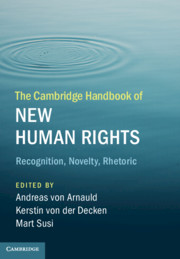Book contents
- The Cambridge Handbook of New Human Rights
- The Cambridge Handbook of New Human Rights
- Copyright page
- Contents
- Figures
- Contributors
- Acknowledgements
- Introduction
- Part I Cross-Cutting Observations
- Part II Public Good Rights
- Part III Status Rights
- Rights of Older Persons
- Rights to Gender Identity
- Rights of Indigenous Peoples
- Animal Rights
- 18 Animal Rights
- 19 Sentience, Form and Breath
- Part IV New Technology Rights
- Part V Autonomy and Integrity Rights
- Part VI Governance Rights
- Index
19 - Sentience, Form and Breath
Law’s Life with Animals
from Animal Rights
Published online by Cambridge University Press: 04 January 2020
- The Cambridge Handbook of New Human Rights
- The Cambridge Handbook of New Human Rights
- Copyright page
- Contents
- Figures
- Contributors
- Acknowledgements
- Introduction
- Part I Cross-Cutting Observations
- Part II Public Good Rights
- Part III Status Rights
- Rights of Older Persons
- Rights to Gender Identity
- Rights of Indigenous Peoples
- Animal Rights
- 18 Animal Rights
- 19 Sentience, Form and Breath
- Part IV New Technology Rights
- Part V Autonomy and Integrity Rights
- Part VI Governance Rights
- Index
Summary
We can track a shifting jurisprudence regarding animals over time and across Europe; it tends to reflect the ongoing struggle between church and state, country and city, coloniser and colonised, ruling and working class, masculine and feminine. This is a struggle for jurisdiction over the bodies of animals which is fascinating for its treatments of those bodies. I am thinking here of, for example, the medieval animal trials documented by E. P. Evans and of the numerous tort and property law cases that have involved animals throughout the early and late modern period. We could also look in general to hunting laws, farming laws, animal welfare laws and others for indications as to changing views over time in relation to certain species and uses of animals. When we do, what becomes evident quite quickly is how our governance of animals has very little to do with specific animals themselves and everything to do with the political economies of humans. Who is allowed to do what, with which animals? For what purpose are the jurisprudential categories of sacred (e.g. ‘endangered’ and sacrificial) and profane (consumable) created? And in turn, how do these categories – by defining – create a separate ontological domain for ‘humans’? For legal theorists and legal anthropologists, ‘animal jurisprudence’ is therefore key to understanding the limitations and potential of what it means for us to be human. And for legal scholars thinking about what it means to have human rights, it is critical to look at how we talk about ‘animal’ rights.
- Type
- Chapter
- Information
- The Cambridge Handbook of New Human RightsRecognition, Novelty, Rhetoric, pp. 253 - 258Publisher: Cambridge University PressPrint publication year: 2020



